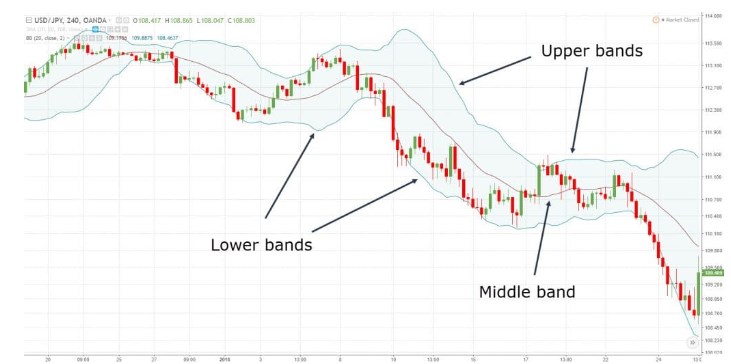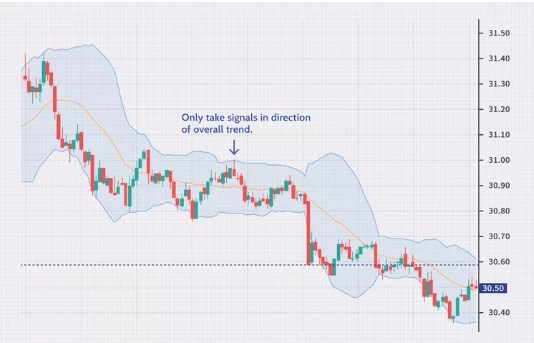Trading is a complex and challenging activity that requires knowledge, skills, and experience. To be successful in the trading world, you need to have a solid understanding of the financial markets, be able to read and analyze charts, and have a reliable trading strategy. One of the most effective trading strategies is the Bollinger Bands trading strategy.
Bollinger Bands explained: What is it and how does it work?
Bollinger Bands is a trading indicator (which consist of 3 lines)

The middle line is a moving average, usually a simple moving average, and the other two lines are the upper and lower bands. The upper band is calculated by adding two standard deviations to the moving average, while the lower band is calculated by subtracting two standard deviations from the moving average.
When the price of an asset moves closer to the upper band, it is considered overbought, and when it moves closer to the lower band, it is considered oversold. Traders use this information to identify potential entry and exit points.created by John Bollinger.
It can help you:
Identify potential overbought/oversold areas
Identify the volatility of the markets
Bollinger Bands advantages
One of the advantages of the Bollinger Bands trading strategy is that it is a relatively simple and easy-to-use tool. Traders do not need to have advanced technical analysis skills to use this strategy effectively. All they need to do is to understand how to read and interpret the Bollinger Bands and to use this information to make informed trading decisions.
Another advantage of the Bollinger Bands trading strategy is that it can be used in different types of markets, including stocks, commodities, and forex. This makes it a versatile tool that can be used by traders in different markets.
Bollinger Bands trading strategy
To use the Bollinger Bands trading strategy effectively, traders need to follow a few simple steps. The first step is to identify the trend of the market. This can be done by analyzing the moving average line of the Bollinger Bands. If the price is above the moving average, the trend is bullish, and if it is below the moving average, the trend is bearish.

The next step is to wait for the price to move towards the upper or lower bands. When the price is close to the upper band, traders can consider selling, while when it is close to the lower band, they can consider buying. Traders should also consider other indicators, such as volume and momentum, to confirm their trading decisions.
It is important to note that the Bollinger Bands trading strategy is not foolproof, and traders should always use other tools and indicators to confirm their trading decisions. Traders should also use stop-loss orders to limit their losses if the trade goes against them.
Frequently asked questions
#1: Hey , what timeframe does the Bollinger Bands work best on?
There’s really no best timeframe out there to use the Bollinger Bands as the concepts I’ve shared can be applied across different timeframes.
So it depends on your trading style and approach:
If you’re a day trader, then you’ll use the Bollinger Bands on the lower timeframe like the 15-minutes or 5-minutes timeframe.
If you’re a swing or position trader, then you’ll use the Bollinger Bands on the daily or the weekly timeframe.
#2: Is there any difference between the accumulation stage of a market and a Bollinger Bands squeeze?
Yes, there are differences. An accumulation stage is a range market within a downtrend, where you can identify resistance and support as price swings up and down within the accumulation.
Whereas in a Bollinger Bands squeeze, the market doesn’t swing up and down because the price action gets really tight and the candles are overlapping one another. So it’s impossible to identify support and resistance in a Bollinger Bands squeeze.
#3: Is it better to use Bollinger Bands to trade breakout or to trade market reversals?
It can similarly serve for both breakout and reversal trades.
You can look to trade breakouts after a Bollinger Bands squeeze.
Or you can also use it to trade market reversals after the Bollinger Bands expand, which shows the increase in volatility of the market. If the price comes to a key market structure like support resistance and then forms a price rejection, that’s a possible opportunity for you to take a reversal trade.
conclusion
the Bollinger Bands trading strategy is a powerful tool that can help traders make informed trading decisions. It is a simple and easy-to-use tool that can be used in different types of markets. However, traders should always use other tools and indicators to confirm their trading decisions and should use stop-loss orders to limit their losses. By mastering this strategy, traders can develop their trading skills and increase their chances of success in the financial markets.
